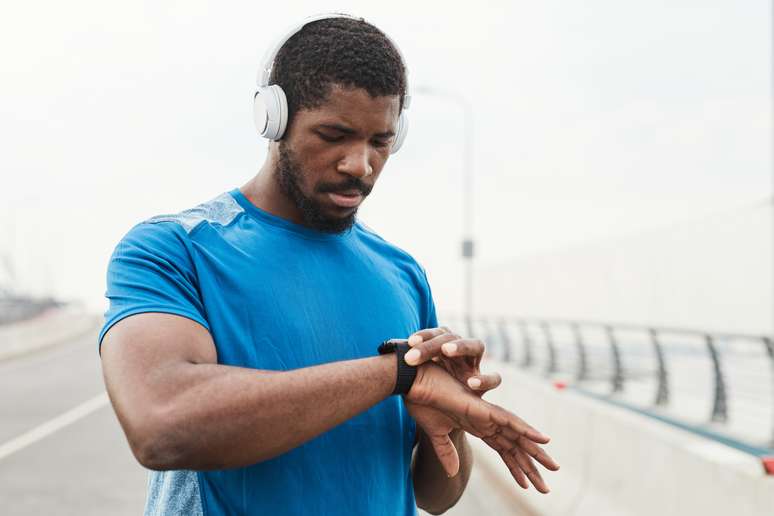This measure of performance can be obtained through tests, but also through sports watches.
VO2 Max is one of the main measures of physical performance, used to assess the body’s maximum capacity to consume oxygen during intense exercise. This metric is particularly relevant for athletes and people who want to improve performance in sports such as cycling, running, swimming and soccer (which require aerobic performance).
With the rise of workout accessories, such as smartwatches and heart rate monitors, VO2 Max has become more accessible, with estimates provided by these devices, but it can also be calculated through medical tests, such as ergospirometry.
Let’s understand exactly what VO2 Max is and how to improve yours to increase your performance!
What is VO2 max?
VO2 Max is the maximum volume of oxygen (in milliliters) a person can utilize per minute, per kilogram of body weight, during exercise. In practical terms, the higher the VO2 Max, the more efficient the body is at using oxygen, which translates into greater aerobic capacity and physical endurance.
This measurement is considered one of the best indicators of cardiovascular fitness and physical fitness, it varies from person to person, depending on factors such as:
- Genetics
- Age
- Sex
- Level of training
Endurance athletes, such as runners and cyclists, tend to have high VO2 max, while sedentary people have lower values.
What is VO2 Max used for?
VO2 Max is used to determine a person’s fitness level and endurance potential. It can also be used to monitor the effectiveness of a training program, since as fitness improves, VO2 Max tends to increase.
Many workout accessories, like smartwatches and other devices, estimate your VO2 max based on your heart rate and other data collected during exercise. While these numbers are approximate, they are still a useful tool for tracking your progress and adjusting your training.
For example, if you’re training for a marathon, tracking your VO2 Max can help you adjust the intensity of your workouts, ensuring you’re building endurance without overexerting yourself. By tracking this metric, you can set short- and long-term goals, gradually improving your performance.
How to increase VO2 Max?
Increasing your VO2 Max requires consistent and efficient training. Here are some effective strategies you can follow to significantly increase your VO2 Max and improve your physical performance:
1. High-intensity interval training (HIIT)
If you want to increase your VO2 Max quickly, HIIT is one of the best approaches. HIIT involves short bursts of intense exercise followed by short recovery breaks. For example, while running, you might alternate 30 seconds of sprinting (fast running) with 1 to 2 minutes of jogging or easy walking. This oscillation between maximum effort and recovery forces the body to adapt, increasing its oxygen consumption capacity.
2. Long-term continuous training
In addition to high-intensity intervals, moderate-intensity, sustained workouts also help increase your VO2 max. These workouts, known as “long runs,” improve your cardiovascular fitness over time, allowing you to exercise longer without tiring.
3. Frequency and consistency in training
Consistency is the key to increasing your VO2 max. Ideally, you should train 4 to 5 times per week, alternating between high-intensity workouts and longer, continuous workouts. This ensures your body receives constant and varied stimulation, promoting physiological adaptations that increase your aerobic capacity.
4. Muscle strengthening training
While the focus is on aerobic endurance, muscle strengthening can also help improve your VO2 max. Stronger muscles use oxygen more efficiently, optimizing their performance. Including strength training sessions, such as squats, deadlifts, and functional exercises, can improve your overall conditioning and help improve your VO2 max.
5. Optimize your recovery
Adequate recovery is essential to any training program aimed at increasing VO2 Max. Your body needs time to adapt to the exertion exerted and this only happens during rest. Get at least 7-9 hours of sleep per night, maintain a balanced diet and sufficient hydration, and include rest days or light exercise between intense workouts.
6. Track your progress
Use smartwatches and other devices to track your VO2 Max While the numbers provided are estimates, they are helpful for seeing how your progress is trending over time. If you notice a plateau, adjust the intensity or variety of your workouts to keep moving forward.
Source: Terra
Ben Stock is a lifestyle journalist and author at Gossipify. He writes about topics such as health, wellness, travel, food and home decor. He provides practical advice and inspiration to improve well-being, keeps readers up to date with latest lifestyle news and trends, known for his engaging writing style, in-depth analysis and unique perspectives.








